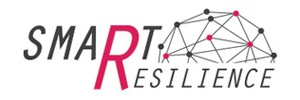Modern society needs resilience management going beyond conventional risk management, in order to address the behavior of large integrated systems and critical infrastructure, in particular, exposed to possible current and future threats. These are, for instance, terrorist attacks, cyber-attacks or extreme weather disrupting the operation of energy supply, water supply, transportation networks, health care, flood protection, financial sector and other critical infrastructures. The “resilience” of an infrastructure describes in these cases the ability of the infrastructure to successfully cope with these possible adverse scenarios/events, including the capacity to prepare, absorb, withstand, recover and adapt. SmartResilience project provides an innovative holistic methodology and the “ResilienceTool” (relying on resilience indicators) for assessing and managing resilience of critical infrastructures. The indicators, in turn, use both conventional and “big” data as the source. The methodology is based on the 55 resilience matrix and the aggregation of the issues and indicators in each cell of the matrix. The phase of “understanding risks”, including the emerging ones, provides the natural link to risk analysis and management. It includes also the modules for optimized decision-making and advanced reporting options compatible with the state-of-the-art approaches (e.g. FEMA). The approach is embedded into the new ISO 31050 standard (under development).
See Example...
